MENU
STIDS 2015 Home
About--
Topic list
Program Cmte
Venue & Local Info
Registration
Program--
Keynote Speakers
Tutorials
Best Paper Award
Agenda & Papers
Download Agenda
Proceedings
Call for Papers
Important dates
Submission details
Classified Session
Download CFP
C4I
Home

SEMANTIC
TECHNOLOGY FOR
INTELLIGENCE,
DEFENSE, AND
SECURITY
Go to: Tutorial B (A.M.) Tutorial C (P.M.) Tutorial D (P.M.)
Wednesday A.M., November 18, 2015
Faculty: Ian Emmons
Description: This tutorial uses an example-based teaching approach. Participants arriving with a basic knowledge of RDF, should leave with a solid understanding of the syntax and structure of the SPARQL query language as a basis for formulating their own SPARQL queries. |
|||
| 09:00 - 10:40 | Session 1 | ||
|
Click for Description
|
|||
| 10:40 - 11:00 | Break |
||
| 11:00 - 12:30 | Session 2 |
||
|
Click for Description
|
|||
| 12:30 | Close |
||
Ian Emmons has over 25 years of software development experience concentrated in various forms of data management, with more than ten years of experience in the Semantic Web community. His Semantic Web experience has emphasized machine-understandable representations of human intent, semantic alignment of multi-source data, coreference resolution, semantic storage and query, and processing of temporal data. Prior to that, his interests included transactional data caching and replication, concurrent processing techniques, object-to-relational mapping, document management, and natural language-assisted information retrieval. His background includes an MA in Mathematics and a BS in Physics from the University of Rochester, three patents, and seven publications.
Go to: Tutorial A (A.M.) Tutorial C (P.M.) Tutorial D (P.M.)
Wednesday A.M., November 18, 2015
Faculty: Michael Uschold and Dave McComb
Description: If you think that getting your (or someone else's) head around OWL is a challenging experience, you have found the right tutorial. There are really just a few foundational building blocks that everything else is built from. There are 1) individual things -- e.g. JaneDoe, 2) kinds of things -- e.g. Organization and 3) kinds of relationships -- e.g. worksFor. That's pretty much it. In this tutorial we will describe the many ways that these things can be combined and used. Most importantly, there are triples that assert relationships between things -- e.g. JaneDoe worksFor Microsoft. There is inference to generate new triples and a few more key things, but not as much as you think. If you are getting started in OWL, this tutorial has everything you need and nothing you don't. |
|||
| 09:00 - 10:40 | Session 1 |
||
|
Click for Description
|
|||
| 10:40 - 11:00 | Break |
||
| 11:00 - 12:30 | Session 2 | ||
|
Click for Description
|
|||
| 12:30 | Close |
||
Michael Uschold is an internationally recognized expert with over two decades experience in developing and transitioning semantic technology from academia to industry. He pioneered the field of ontology engineering, co-authoring the first paper and giving the first tutorial on the topic in 1995 (in London). From October 2010, he has been working as a senior ontology consultant at Semantic Arts, training and guiding clients to better understand and leverage semantic technology. He has built commercial enterprise ontologies in finance, healthcare, legal research, electrical power, consumer products, manufacturing and media assets. During 2008-2009, Uschold worked at Reinvent on a team that developed a semantic advertising platform. As a research scientist at Boeing from 1997-2008 he defined, led and participated in numerous projects applying semantic technology to enterprise challenges. He is a frequent invited speaker and panelist at national and international events, and serves on the editorial board of the Journal for Web Semantics. He has given numerous tutorials and training classes. He received his Ph.D. in AI from Edinburgh University in 1991 and an MSc. from Rutgers University in Computer Science in 1982.
Dave McComb is a hands on practitioner and thought leader in the area of applying Semantic Technology to Enterprise Architecture and Applications. For fourteen years as co-founder and President of Semantic Arts he has managed major Semantic Technology projects with over a dozen large enterprises, including Goldman Sachs, Broadridge Financial Systems, Procter & Gamble, Lexis Nexis, Sentara Healthcare, Sallie Mae, and seven different Agencies in the States of Colorado, Texas and Washington. Dave is the author of Semantics in Business Systems, and was the co-founder of the Semantic Technology Conference, the go to place for companies looking to commercialize semantics. He is a frequent speaker and writer on the topic and has inspired many to enter the field. In the early 90's Dave pioneered an approach to ontology development based on facilitated brainstorming in focused Semantic Modeling sessions. In the intervening 20 years he has lead over 200 of these sessions and built almost as many ontologies. Prior to founding Semantic Arts, Dave spent 13 years with Andersen Consulting (the part that became Accenture) designing and building Enterprise Applications for large firms including: Boise Cascade, Georgia Pacific, Wildish Construction, Norton Abrasives, the US Geological Survey, Bougainville Copper, US West and Martin Marietta (now Lockheed Martin). He founded First Principles and co-founded Velocity Healthcare.
Go to: Tutorial A (A.M.) Tutorial B (A.M.) Tutorial D (P.M.)
Wednesday P.M., November 18, 2015
Faculty: Dave McComb, Dan Carey and Todd Schneider
Description: This tutorial is strategically aimed at promoting the idea that an Enterprise Ontology is a key first step in rationalizing existing systems and adopting new sources of data, and that the development of such an ontology is not the onerous task it was once believed to be. There is a vital need for enterprises to have a comprehensive enterprise ontology in order to accommodate and survive the tsunami of data that is coming. However, we have discovered that few enterprises have the appetite for project of the duration that most enterprise data modeling projects take. We have spent the last several years working on a more agile approach to building an enterprise ontology, and have practiced it with several clients. A similar tutorial was presented at the SmartData Conference in San Jose this last August and received glowing evaluations (9.6 out of 10 on "overall value of tutorial"). |
|||
| 13:30 - 15:10 | Session 1 |
||
|
Click for Description
|
|||
| 15:10 - 15:30 | Break |
||
| 15:30 - 17:00 | Session 2 | ||
|
Click for Description
|
|||
| 17:00 | Close |
||
Dave McComb is President and co-founder of Semantic Arts, an independent consulting firm specializing in helping enterprises adopt semantic technology in their Enterprise Architectures. He has over 30 years of experience with enterprise level systems and enterprise architecture. He has built enterprise ontologies for over a dozen major enterprises, including Procter & Gamble, Schneider-Electric, Goldman Sachs, Broadridge Financials, Lexis Nexis, Sallie Mae, and several State Agencies in Colorado, Texas and Washington. He was the co-founder of the Semantic Technology Conference and the author of Semantics in Business Systems.
Dan Carey has recently joined Semantic Arts as an ontologist. Dan has had over 20 years data modeling experience with a variety of State and Federal agencies. He most recently led a key portion of the ontology modeling at the Alcohol, Tobacco Taxation and Trade Bureau projects, as well as leading enterprise level data management strategy at the Defense HealthCare Management Systems DMIX program.
Todd Schneider will soon be joining Semantic Arts as an ontologist. Todd has over 25 years of increasing levels of responsibility in data and ontology intensive projects. He was a Senior Principal Systems Engineer at Raytheon where is lead a number of semantic based projects, primarily for Defense Agency customers. Todd has been an active participant in the Ontolog Forum and the Network Centric Operations Industry Consortium.
Go to: Tutorial A (A.M.) Tutorial B (A.M.) Tutorial C (P.M.)
Wednesday P.M., November 18, 2015
Faculty: Cory Casanave
Description: Sharing, federating and analyzing threat and risk information across domains, disciplines, communities and organizations is essential to mitigate the sophisticated attack vectors we face across the physical and cyber worlds. The operational threat and risk information sharing and federation model standards effort (1) that is in the final stages of adoption within the Object Management Group (OMG) enables wide-scale federation and sharing that includes an all-threats approach that includes the nexus of cyber and physical. By using a semantic conceptual model (a.k.a. Ontology) implementations of this specification enables "connecting the dots" among threat and risk information sources, technologies, data formats, consumers and capabilities. This tutorial will introduce the threat and risk specification and provide guidance on implementing the standards based capability for Intelligence, Defense, and Security. |
|||
| 13:30 - 15:10 | Session 1 |
||
|
Click for Description
|
|||
| 15:10 - 15:30 | Break |
||
| 15:30 - 17:00 | Session 2 | ||
|
Click for Description
|
|||
| 17:00 | Close |
||
Cory Casanave is the chief architect of the threat and risk submission team with decades of experience in standards, information sharing, model driven architecture and semantic technologies. Mr. Casanave is CEO of Model Driven Solutions and a member of the board of directors for the Object Management Group.
